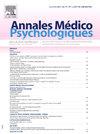Prosopagnosie et syndrome de Capgras : deux syndromes en miroir ?
IF 0.5
4区 医学
Q4 PSYCHIATRY
引用次数: 0
Abstract
First described in the 19th century in patients with brain lesions, prosopagnosia was named in 1947 by Joachim Bodamer (1910–1985), a German neuropsychiatrist. The term refers to the inability to recognise a familiar face, a rarely isolated symptom. Prosopagnosia is thought to result from brain lesions, predominantly at the ventral right temporo-occipital junction. There are more common cases of developmental prosopagnosia, where no lesion has been identified. Capgras syndrome (CS), described by Joseph Capgras (1873–1950), a psychiatrist, consists of the persistent belief that a close relative, identified, has been replaced by a look-alike. SC, considered a delusional disorder of identification or familiarity, has been described in chronic psychoses, mainly schizophrenia. It is also reported in the course of neurodegenerative diseases (mainly Alzheimer's disease, Lewy body dementia, Parkinson's dementia). Lesion-based forms have recently been described. Prosopagnosia and SC were initially thought to result from mirror-image lesions involving a single factor, one affecting an overt ventral circuit for face recognition (in the case of prosopagnosia), the other a covert dorsal circuit involved in emotional and vegetative responses (in the case of CS). Lesion network mapping has been used in both lesion-related conditions and suggests a more complex figure. Lesions causing prosopagnosia were correlated with one of the main regions associated with face recognition, the right fusiform face area, and anticorrelated with left frontal regions possibly involved in visual attentional control. In lesional forms of CS or other delusional misidentification syndromes, there was a correlation with left retrosplenial cortex, an area associated with familiarity processing, and a correlation with right frontal regions associated with belief evaluation. This finding supports the intervention of two factors in CS, one generating the impaired familiarity associated with perception and the other the genesis and persistence of a delusional idea. The debate on the mechanisms of CS is not settled, especially as it is limited to its lesional forms, but studies using lesion network mapping already mark a more general paradigm shift, with attention shifting from lesions (clinico-anatomical method) to circuit dysfunction.
嗜视症和卡普拉斯综合征:两种镜像综合征?
面容失认症(prosopagnosia)最早出现在 19 世纪的脑损伤患者身上,1947 年由德国神经精神病学家约阿希姆-博达默(Joachim Bodamer,1910-1985 年)命名。这个词指的是无法辨认熟悉的面孔,是一种很少见的孤立症状。嗜貌症被认为是大脑病变引起的,主要发生在右侧颞枕交界处的腹侧。还有更常见的发育性前脸失认症病例,在这些病例中没有发现任何病变。卡普格拉斯综合症(Capgras Syndrome,CS)由精神病学家约瑟夫-卡普格拉斯(1873-1950 年)描述,包括持续相信已确认的近亲已被相似的人取代。SC被认为是一种辨认或熟悉妄想症,在慢性精神病(主要是精神分裂症)中有所描述。在神经退行性疾病(主要是阿尔茨海默病、路易体痴呆、帕金森痴呆)的病程中也有报道。最近还描述了以病变为基础的形式。嗜脸症和SC最初被认为是由涉及单一因素的镜像病变引起的,其中一个影响到人脸识别的显性腹侧回路(嗜脸症),另一个影响到情绪和植物反应的隐性背侧回路(CS)。在这两种与病变有关的情况下,都使用了病变网络映射,并显示出更复杂的图形。导致面容失认症的病变与与面容识别相关的主要区域之一--右侧纺锤形面容区--相关,而与可能参与视觉注意力控制的左侧额叶区域反相关。在CS或其他妄想性错误识别综合征的病变形式中,与左侧后脾皮层(一个与熟悉性处理相关的区域)存在相关性,与右侧额叶与信念评估相关的区域存在相关性。这一发现支持了两个因素对 CS 的干预,一个是与感知相关的熟悉度受损,另一个是妄想想法的产生和持续。关于CS机制的争论尚未尘埃落定,特别是因为它仅限于病变形式,但使用病变网络映射的研究已经标志着更普遍的范式转变,注意力从病变(临床解剖学方法)转移到电路功能障碍。
本文章由计算机程序翻译,如有差异,请以英文原文为准。
求助全文
约1分钟内获得全文
求助全文
来源期刊

Annales medico-psychologiques
医学-精神病学
CiteScore
1.30
自引率
33.30%
发文量
196
审稿时长
4-8 weeks
期刊介绍:
The Annales Médico-Psychologiques is a peer-reviewed medical journal covering the field of psychiatry. Articles are published in French or in English. The journal was established in 1843 and is published by Elsevier on behalf of the Société Médico-Psychologique.
The journal publishes 10 times a year original articles covering biological, genetic, psychological, forensic and cultural issues relevant to the diagnosis and treatment of mental illness, as well as peer reviewed articles that have been presented and discussed during meetings of the Société Médico-Psychologique.To report on the major currents of thought of contemporary psychiatry, and to publish clinical and biological research of international standard, these are the aims of the Annales Médico-Psychologiques.
 求助内容:
求助内容: 应助结果提醒方式:
应助结果提醒方式:


